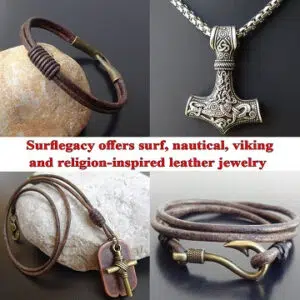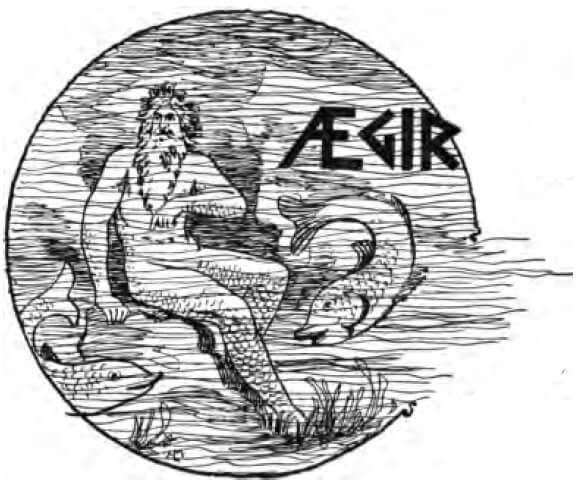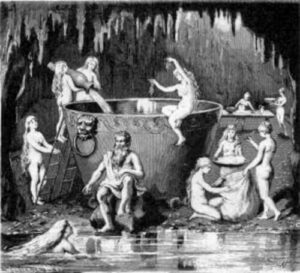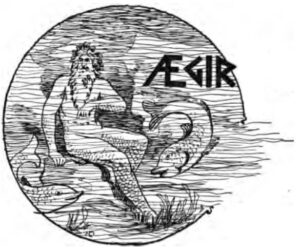In Norse mythology, the vast ocean was personified by the enigmatic figure of Aegir. Often associated with brewing ale and hosting grand feasts for the gods, Aegir played a significant but subtle role in the Norse pantheon.
This sea jötunn, whose name means “sea” in Old Norse, lived on the isle of Hlésey, also known as Læsø. Together with his wife, the goddess Rán, Ægir ruled over the waters, and their nine daughters embodied the waves of the sea.
The ocean was the lifeblood of the Viking people, providing vital resources yet also destructive capability. They revered Aegir as the god embodying this complex duality within the surrounding waters – as both the giver of sustenance and trade and also the bringer of tempests.
From the viewpoint of the seafaring Norse, the bountiful yet volatile ocean was central to existence. Aegir’s personified form gave vivid meaning to this relationship with the capricious but precious sea.
His tales highlight the interdependence yet apprehension these people felt toward the waters that sustained them yet could unleash devastating storms without warning.
Key Points
- Ægir, also known as Aegir or Hlér, is a jötunn and the personification of the sea in Norse mythology.
- He hosts grand feasts for the gods and is associated with brewing ale.
- Ægir is married to the sea goddess Rán, and their nine daughters represent the waves of the sea.
- He may be the grandfather of the god Heimdall, whose mothers are the nine daughters of Ægir and Rán.
- Ægir’s role as a jötunn or a god is a matter of debate among scholars, but he enjoys a friendly relationship with the Æsir gods.
- Representations of Ægir often show him as an older man with a white beard.
- He is not extensively represented in modern culture, but he has inspired art and the naming of celestial bodies.
Who is Ægir?
In Norse mythology, Ægir was one of the three giants living among the Aesir gods, along with his brothers, Kari (representing air) and Logi (representing fire). As the personification of the sea, his powers were related to water and the ocean.
The river Eider was even called “Aegir’s door,” and he was known to cause tidal waves and eddies that engulfed ships at sea. In the Norse pantheon, Ægir’s counterparts were the Greek Poseidon and the Roman god Neptune.
Aegir’s Origins and Family
As a personification of the ocean itself, Aegir has no recorded origin story. He simply exists as long as the sea itself flows around Scandinavia and beyond. His name comes from the Old Norse word for “water” or “sea”, emphasizing how Aegir and the ocean are one and the same.
Aegir took the jötunn Rán as his wife. A goddess of the sea in her own right, Rán embodied the dangerous and destructive aspects of ocean storms and briny depths. She caught sailors in her net and pulled them into the sea. Together they had nine daughters known as the billow maidens, each embodying a different quality of ocean waves. The Nine Daughters of Aegir and Rán are:
- Dúfa – “The Pitching One”
- Blódughadda – “Bloody-Hair”
- Hefring – “Riser”
- Uðr – “Frothing Wave”
- Hrönn – “Welling Wave”
- Bylgja – “Breaker”
- Dröfn – “Foam-Fleck”
- Kólga – “The Cold One”
- Himinglæva – “That Through Which One Can See the Heavens”
Ægir, Rán and their nine daughters prepare a huge vat of ale
Aegir’s Relationship to Heimdall
According to some Norse sources, Aegir may also be the grandfather of the god Heimdall, watcher of the rainbow bridge Bifrost. The Völuspá hin skamma names nine mothers for Heimdall who could be waves or sea goddesses.
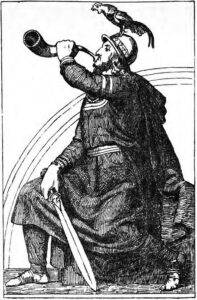
Heimdall
Other sources specifically name the Nine Daughters of Aegir as his mothers. This has led to the common understanding that Heimdall is the son of Aegir’s nine wave daughters, making Aegir his grandfather. However, the connections remain somewhat ambiguous.
As Heimdall is destined to kill and be killed by Loki during Ragnarok, this family tie connects Aegir’s feasts, Loki’s banishment, and the coming end times in Norse mythology.
Jötunn or God?
Ægir’s classification as a jötunn or a god is a subject of scholarly debate. While he is often listed as a jötunn, he has a friendly relationship with the Æsir gods and even hosts feasts for them.
Some historians believe that he may belong to an ancient dynasty of gods predating the Æsir and the Vanir. Others suggest that not all jötnar are evil and that Ægir represents a benevolent aspect of these nature deities.
Aegir’s Appearance
As a personification of the sea itself, Aegir’s appearance could change and shift like the waves and swells of the ocean. However, he was most often depicted as an older, mighty man with a long white beard. He sometimes had wild locks of hair or even a head shaped like waves and foam.
His fingers were long, gnarled, and claw-like, suited for grasping prey from the depths. Aegir represented the untamed power and treasures of the sea, as well as its mysteries and dangers.
Aegir’s Hall
Unlike other Norse gods who lived in Asgard or Vanaheim, Aegir made his home at the bottom of the ocean. His fantastic hall was built beneath the waves near the island of Hlesey. Here he lived with his wife Rán and their nine wave daughters.
As befitting a god of the sea, Aegir possessed great knowledge of brewing ale. He supplied endless quantities of ale, mead, and other alcoholic drinks to the gods when they visited his hall. His servers Fimafeng and Eldir kept the drinks flowing.
Aegir was known for welcoming the Æsir gods as guests for grand feasts in his underwater abode. Odin and other major gods would make the journey to the sea floor to revel in Aegir’s hospitality and partake of his magical ale.
The god Bragi entertained guests with stories and songs during the feasts. Aegir’s ale was said to come from a large pot or cauldron, from which it flowed endlessly, never running out no matter how much the gods drank. Mead from this vessel was made from the blood of Kvasir, imbuing it with wisdom and inspiration.
The Feast that Led to Loki’s Punishment
At one of these legendary parties in Aegir’s hall, the festivities took a fateful turn because of the trickster god Loki. The naughty Loki killed one of Aegir’s servers, Fimafeng, apparently just for complimenting the other gods while bringing their drinks.
This unforgivable act set in motion a chain of events where the angry gods chased Loki from the hall and decided that his mischief had gone too far. They imprisoned the trickster god in a cave, chaining him there as punishment for his crime at Aegir’s feast.
Loki’s wife Sigyn stayed loyal and tried to ease his suffering, but Loki was trapped in the cave until Ragnarok began. This imprisonment was the starting point for Loki’s revenge against the other gods, setting him on the path to aid the giants during the eventual end times battle.
So while Aegir himself did not take direct action against Loki, the offense at his feast was the tipping point that condemned Loki and set Ragnarok in motion. Aegir’s legendary parties for the gods held grave consequences.
Ægir’s Feasts and His Relationship with the Gods
Ægir’s grand feasts for the gods were a notable aspect of Norse mythology. These feasts were known as “ale-brewings” or “ale-feasts,” and they were extravagant events held in his magnificent undersea halls. During these gatherings, the gods would come together to celebrate, drink ale brewed by Ægir himself, and indulge in merrymaking.
Despite being a jötunn, Ægir enjoyed a friendly relationship with the gods. He was a gracious host, and the gods respected him, knowing the importance of maintaining a good rapport with the personification of the sea. Ægir’s ability to brew excellent ale and his willingness to share it with the gods further endeared him to the divine assembly.
Aegir’s Presence in Old Norse Texts and Mythology
While Ægir is not as prominent as some other Norse deities, he appears in several Old Norse poems and sagas. One of the most famous mentions of Ægir is in the poem “Lokasenna,” where Loki, the trickster god, crashes one of Ægir’s feasts and proceeds to insult and provoke the other gods.
This event results in a chaotic and heated exchange of words, showcasing Ægir’s role as a facilitator of divine gatherings and the tensions that can arise among the gods.
Another significant reference to Ægir is found in the poem “Hymiskviða” (The Lay of Hymir). In this poem, Thor, the thunder god, visits Ægir to procure a large cauldron for brewing ale.
During the visit, Thor faces various challenges and displays his legendary strength while trying to convince the giant Hymir to lend the cauldron. The poem emphasizes Ægir’s role as a keeper of valuable objects, particularly those related to brewing.
Aegir’s Role and Meaning
As a personification of the ocean itself, Aegir did not directly take part in myths and legends as extensively as other Norse gods. However, his existence as a part of the seascape held deep meaning for Norse culture and mythology.
- He represented the sea as a life-giving but also destructive force. The ocean provided fish, trade routes, and new lands for exploration and plunder. But it also brought storms, tidal waves, and ship-devouring monsters that could doom sailors and coastal villages. Aegir embodied this dual nature.
- As a brewer and host, Aegir brought bounty and community but also unintended chaos. His parties brought the gods together, but one feast had dire consequences in the death of Fimafeng.
- His possible family tie to Heimdall connected Aegir to the fate of the gods and Norse cosmology as a whole. Aegir’s actions reverberated across worlds.
- For a seafaring culture like the Vikings, Aegir was a key symbol of both the seas that sustained and inspired them and the mysteries and dangers lurking below the waves. Reverence for Aegir showed respect for the power of the ocean.
Aegir’s Legacy
References to Aegir continue to appear in modern popular culture, especially in works influenced by Norse mythology. Some examples include:
- Aegir is the name given to one of Neptune’s moons. This seems a fitting tribute given Aegir’s role as a sea god.
- The mouth of the river Trent in England is known as Aegir’s force. Here Aegir’s power over waterways continues.
- Darkest Dungeon location The Cove refers to “Aegir’s embrace”, meaning sailors dying at sea.
- In the God of War games, Kratos follows a compass marked with a symbol of Aegir to navigate the Norse world.
- Aegir is referenced in the storm-controlling Kantus monks of Gears of War.
- In Final Fantasy XIV, Aegir is worshipped by pirates and appears as an aquatic monster.
Key Takeaways on Aegir, Norse God of the Sea:
- Aegir literally represented the ocean itself in Norse mythology rather than presiding over it like Poseidon.
- His hall provided endless ale and hospitality, but a murder at one feast led to Loki’s imprisonment, setting in motion Ragnarok.
- Aegir exemplified the sea as source of prosperity and peril for Norse society. He embodied the Northern Ocean’s dual might and majesty.
- While subtle in myths, he remains an iconic personification of the mystery and power of the seas that both inspired and endangered the Viking people.
Differences between Poseidon and Aegir
The main differences between Poseidon and Aegir are:
- Origin – Poseidon is from Greek mythology while Aegir is from Norse mythology.
- God status – Poseidon is one of the main Greek gods, one of the Twelve Olympians, while Aegir is a more minor Norse deity.
- Domain – Poseidon is seen as god of the entire sea, while Aegir is specifically associated with the northern Atlantic ocean.
- Personification – Aegir is the embodied ocean itself in Norse myth, whereas Poseidon rules over the sea but is not seen as the literal sea.
- Appearance – Poseidon is depicted as human-like, often with a trident, while Aegir is described as looking like the ocean with shimmering hair and beard.
- Temperament – Poseidon is known for having a volatile temper, while Aegir is mostly benevolent and generous as a host.
- Myths – Poseidon plays a central role in many Greek myths, while Aegir is more subtle in Norse tales, known for hosting feasts.
- Symbolism – They both represent the sea’s power, but Aegir is more tied to the northern waters as a life source for Vikings.
So in summary, while both are sea deities, Poseidon is a main Greek god who rules the seas, whereas Aegir literally embodies the northern ocean itself in a more minor role in Norse myths.
Conclusion
The enigmatic Ægir, a jötunn and personification of the sea in Norse mythology, remains a captivating figure. His role as a benevolent giant or a god, his grand feasts for the gods, and his connection to the ocean’s vastness all contribute to his intriguing legacy.
Though not as widely recognized as some of the more prominent Norse gods, Ægir’s presence adds depth and complexity to the rich tapestry of Norse mythology.
As we delve into the realms of ancient mythologies, Ægir stands as a reminder of the wonders and mysteries that continue to inspire human imagination and creativity, even in the contemporary world.
Whether through the stars that bear his name or the occasional references in art and literature, Ægir lives on, a testament to the enduring power of myth and storytelling.
Shop Norse Jewelry
Are passionate about Norse Mythology?
Finding the ideal piece of Norse Jewelry can be challenging and time-consuming, especially if you lack inspiration or don’t know where to look.
Surflegacy, has you covered. We have a wide range of Handmade Jewelry in various styles, shapes, colors, and materials, to accentuate your Norse spirit and look. Do not hesitate to visit our selection HERE
Whatever you wear, you’ll find the ideal trendy piece to complement your wardrobe. Our jewelry is designed to be worn every day, no matter where you go or what season is. Are you ready to step up your wardrobe game?
